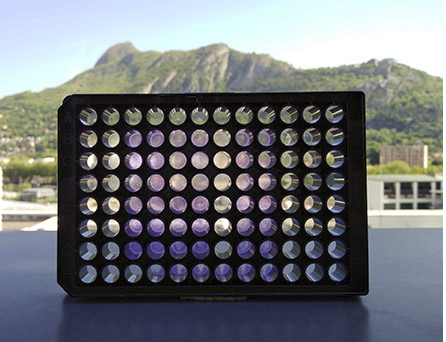BIOACTIVECOATINGS
High-speed mini human tissues


Benefits
- Thin biomimetic films
- Compatible with microplate readers and optical microscopes
- In vitro drug assay for stem cells and mini-tissues in physiological conditions of growth
Key words
- Biomimetism in vitro diagnosis
- High-speed test
- Regenerative medicine
Intellectual Property
- 2 patents
- 1 software
Laboratory
- LMGP
Institutions
- CNRS
- GRENOBLE INP-UGA
Linksium Continuum
- Maturation
- Incubation
Context
In vivo, the cells are surrounded by their extra-cellular matrix and subject to biochemical and biophysical signals. At present, cell cultures are performed on stiff materials such as glass or plastic, whose properties are very different from the physiological matrix.
Technology
BioactiveCoatings involves depositing biomimetic films at the bottom of cell culture plate wells, regardless of the plate format chosen. Production of plates containing the biomimetic film has already been automated, currently with a reliability rate of over 93%. These films can contain proteins or peptides derived from the extra-cellular matrix, making them bioactive.
Advantages
The biomimetic films copy physiological conditions as they provide the cells with bioactive molecules and their stiffness is adjustable. They make it possible to identify new biological phenomena, previously hidden in traditional culture conditions.
As the films are transparent, the cultured cells can be analysed directly by any type of plate reader and optical microscope. The plates can be dried, sterilised and stored dry for at least two years.
State of progress
The automated coating technique has been validated and optimised in connection with an ERC-POC. Amplification of biochemical and biophysical signals by the biomimetic films has been proved for muscle, cancer, and bone stem cell cultures. Results were obtained for eight different proteins as well as peptides. The first POC will concern regeneration of mini bone issues to study bone and cancer pathologies.
Applications
- In vitro diagnosis
- Cell biology
- Cell therapy
- Regenerative medicine

